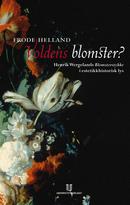Helland and the "flower piece"

Frode Helland has written an analysis of Jan van Huysums blomsterstykke with the title Voldens blomster? Henrik Wergelands Blomsterstykke i estetikkhistorisk lys (Universitetsforlaget 2003). (The flowers of violence? Henrik Wergeland's Flower piece in light of history of aestethics). This new analysis of one of Wergeland's most important works has many strong points, particularly where Helland shows us the work's context and how it enters the greater discurse on the relation of poetry to painting and art to reality.
A couple of issues merit some discussion.
On page 158, Helland comments on the verse where the poem's "I" sees "deceased lovers' faces" in the flower painting. (A translator's note: the English word "lover" is not gender-specific, the original Norwegian text makes it clear that the faces are female). Helland immediately associates the modern connotations of the word "lover" and concludes that the painting reminds the speaker of prostitutes he has paid visits to.
However, in both English and Norwegian the word "lover" seems to have changed meaning over time - note for example how Dickens used the phrase "Little Dorrit's lover" about a boy who had a crush on "Little Dorrit" but never even dared tell her. This is clearly miles from modern usage. While sexuality has become less taboo and claimed its current mind share of the public discourse, the meaning "sex partner" has sort of taken over the word "lover" (with some help from D.H.Lawrence I guess). It is interesting to note that exactly the same shift of meaning has happened in Norwegian and English.
Of course Wergeland's usage of "lover" predates this development. Hence I doubt that the poet intended the interpretation Helland provides. For me this is simply a sort of "advance notice" of the "story in the story" and the tragic love affairs of the three women Narcissa, Klara and Katarina in the next part of the poem. In this context, "female lover" just means "woman who is in love".
I quite like Helland's interpretation of Blomsterstykket as a discurse on the violence art and its stylization, and to what extent the demands of form and style in art commits brutal crimes against life and reality. (Since I'm at the moment of writing in the middle of a dance piece rehearsal period with stiff muscles and aching bruises it would be hard to deny that processes of stylization can be quite violent.. Perhaps most in fields like dance and sports where the performers must adapt their own personal movements and body to the work.)
But Helland assigns the same function to all violence in the text. It looks like he believes Wergeland's message (though with some ambivalence) is that even war was necessary to create the piece of art, and thus even the sufferings of war are justified by the final artwork...
artistic creativity, motivation and destruction are connected. (...) violent crimes against innocent people are the foundations for art . (p. 172)
This means he misses a possible overall interpretation. Because another layer of this work discusses the relation between pain/suffering and art. Wergeland seems to explore the apparent paradox that a country which has been through a terrible civil/religious war, refines the peaceful, aestetic flower painting - and Wergeland reads a therapeutic effect which explains the paradox into the painting.
There are two paralell cases of violence in the poem. One is the war and the attack on the town, the other occurs when van Huysum takes old Adrian's flowers. This second case is explicitly justified by the "tear of forgiveness" at the end. Wergeland could be expressing the possible therapeutic effect of art, how it helps old Adrian to see the sufferings and sorrows the war inflicted on him transformed into a beautiful painting.
<<: Interesting article on upbringing -- Taste of creeping bellflower
